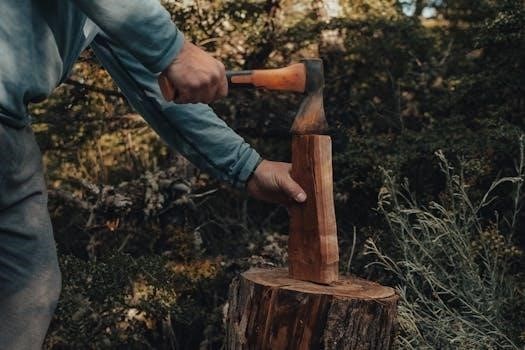In today’s world, many are yearning for simpler times, seeking a connection to the past. This longing fuels a rediscovery of traditional skills, offering self-sufficiency, satisfaction, and a deeper understanding of heritage.
The Enduring Value of Old-Fashioned Practices
Old-fashioned practices offer a sense of accomplishment that is hard to come by elsewhere. Imagine the joy of baking a warm loaf of bread from scratch! Traditional skills offer more than just products; they offer a connection to heritage and a sense of place. These skills increase self-reliance, reduce dependence on technology, and foster creativity. Mastering them provides a sense of control and empowerment in a world that often feels chaotic. By embracing these practices, we not only learn valuable skills but also rediscover a more sustainable and fulfilling lifestyle, grounding ourselves in timeless wisdom.
Gardening⁚ Cultivating Self-Sufficiency
Gardening empowers individuals to grow their own food, fostering self-reliance and a connection to nature. This practice provides fresh, healthy produce while reducing reliance on commercial agriculture.
Growing Food and Herbs Using Traditional Methods
Traditional gardening emphasizes natural techniques, eschewing synthetic fertilizers and pesticides. Instead, it focuses on soil health through composting and crop rotation. Heirloom seeds, passed down through generations, are favored for their resilience and unique flavors. Companion planting, where specific plants are grown together for mutual benefit, is also a key component. Consider also starting a small plot of land or using containers on a patio or balcony. This approach ensures sustainable and flavorful harvests, connecting gardeners to the wisdom of ancestors and the rhythms of nature. You can browse the gardening section and reach out to us with any questions you might have.
Composting⁚ Turning Waste into Garden Gold
Composting transforms kitchen scraps and yard waste into a valuable resource. This sustainable practice enriches soil, reduces waste, and creates a thriving garden ecosystem, embodying resourcefulness and environmental stewardship.
Recycling Organic Material for Soil Enrichment
Composting is a cornerstone of sustainable gardening, offering a natural and effective way to enrich soil. By recycling organic materials like kitchen scraps, yard waste, and even paper products, you create a nutrient-rich amendment that benefits your garden. This process not only reduces landfill waste but also improves soil structure, enhances water retention, and provides essential nutrients for plant growth.
Compost acts as a natural fertilizer, promoting healthier plants and abundant harvests. Embracing composting aligns with traditional practices of resourcefulness, transforming discarded materials into a valuable asset for your garden and promoting environmental responsibility.

Chicken Keeping⁚ A Heritage of Sustenance
Chicken keeping connects us to a rich history of self-reliance. Raising chickens provides fresh eggs, meat, and pest control, fostering a connection to traditional farming practices and sustainable living.
Traditional Practices for Raising Healthy Chickens
Traditional chicken keeping emphasizes natural methods for raising healthy, productive flocks. Central to this approach is providing ample space for free-ranging, allowing chickens to forage for insects and vegetation, supplementing their diet naturally. A clean and spacious coop is crucial, offering protection from predators and the elements. Dust baths are essential for parasite control, while natural supplements like herbs and garlic boost immunity. Observing chicken behavior helps detect early signs of illness, allowing for prompt, natural remedies. Selective breeding preserves heritage breeds known for disease resistance, creating resilient, self-sufficient flocks. These time-tested practices ensure thriving chickens.

Livestock Management⁚ Dairy, Pigs, and Poultry
Managing livestock involves heritage breeds for sustenance and pest control. Dairy cows provide milk, pigs offer meat, and poultry delivers eggs. This integrated approach promotes self-sufficiency and natural resource utilization.
Raising Heritage Breeds for Food and Pest Control
Heritage breeds offer unique benefits in livestock management. Dairy cows, like Jerseys, yield creamy milk for butter. Pigs provide high-quality meat. Poultry, including chickens, turkeys, and guineas, offers meat and eggs. These breeds contribute to a sustainable food supply. Additionally, guineas naturally control pests. They roam the property, reducing flea, tick, and snake populations. Heritage breeds’ hardiness and superior taste make them valuable for homesteads. Raising livestock requires commitment, but it provides homegrown food and connects to simpler, more fulfilling ways of living.
Butter Churning⁚ A Hands-On Tradition
Butter churning, a time-honored practice, offers a connection to the past and yields fresh, flavorful butter. It’s a rewarding skill that brings simple pleasures to modern life.
Making Butter from Fresh Cream
The process of making butter begins with high-quality fresh cream, ideally from heritage breed cows like Jerseys. This cream is then agitated, either in a traditional churn or a modern appliance like a stand mixer. As the cream is churned, the fat molecules begin to clump together, separating from the buttermilk. This requires consistent effort and patience, a testament to the hands-on nature of the skill. Once the butter forms, it’s rinsed to remove any remaining buttermilk, resulting in a rich, creamy spread that elevates any meal. Making butter is a truly rewarding experience.
Cooking from Scratch⁚ Wholesome Homemade Meals
Embrace the art of cooking from scratch, using fresh, unprocessed ingredients. This mindful approach ensures nutritious, delicious meals while avoiding additives and preservatives. Reconnect with the joy of homemade goodness.
Preparing Meals with Fresh, Unprocessed Ingredients
Cooking from scratch offers a return to wholesome eating, emphasizing the use of fresh, unprocessed ingredients. This approach allows for greater control over what you consume, avoiding harmful additives and preservatives often found in processed foods. By preparing meals with whole foods, you can create dishes that are both nutritious and delicious. Embrace the simplicity and satisfaction of cooking with ingredients straight from the garden or local farmers market. Discover the joy of nourishing your body with meals made with love and care, promoting better health and well-being through mindful eating habits.
Baking Bread⁚ A Comforting Aroma of Home
The scent of baking bread evokes feelings of warmth and nostalgia. This time-honored tradition creates nourishment and comfort, connecting us to generations past through a sensory experience.
The Art of Traditional Bread Making
Traditional bread making is a craft, more than just following a recipe. It involves understanding the ingredients, the process, and the environment. From selecting the right flour to nurturing the yeast, each step contributes to the final product. Kneading the dough develops gluten, providing structure. Allowing it to rise creates the airy texture we love. Baking transforms simple ingredients into a comforting staple. This is a way to connect with history, nourish ourselves, and create something beautiful with our own hands. It fills the home with an irresistible aroma.
Food Preservation⁚ Extending the Harvest
Food preservation is the art of extending the harvest, a way to enjoy summer’s bounty throughout the year. It ensures we have access to nutritious food, regardless of the season.
Canning, Pickling, and Drying Techniques
Canning, pickling, and drying are age-old techniques for preserving food, each with its own merits. Canning involves sealing cooked food in airtight jars, preventing spoilage. Pickling uses brine or vinegar to inhibit bacterial growth, creating tangy delights. Drying removes moisture, concentrating flavors and extending shelf life. These methods, passed down through generations, enable us to savor seasonal harvests. Mastering these skills empowers self-sufficiency. They also reduce food waste, and connect us to traditional practices. Safe canning requires precise methods. Pickling offers creative flavor combinations. Drying preserves herbs, fruits, and vegetables. Embrace these techniques to extend your harvest. Enjoy the taste of summer, all year round!

Sewing and Quilting⁚ Creating with Fabric
Sewing and quilting offer a creative outlet, transforming fabric into functional and beautiful items. These skills provide a sustainable way to mend clothing, craft personalized gifts, and connect with textile arts.
Handcrafting Textiles for Practical Use and Art
Handcrafting textiles through sewing and quilting bridges functionality and artistry. These skills empower individuals to create bespoke clothing, cozy quilts, and decorative items, all while fostering creativity and resourcefulness. Beyond mere utility, these practices offer a tangible connection to heritage, echoing the resourcefulness of past generations who relied on handcrafting for survival and comfort. Embracing handcrafting allows for personalized expression, transforming simple fabrics into cherished heirlooms. Mastering these skills provides not only practical benefits but also a profound sense of accomplishment and artistic fulfillment. The ability to mend, repair, and create allows for a sustainable and mindful approach to consumption.

Woodworking⁚ Crafting with Timber
Woodworking, a traditional craft, transforms raw timber into functional and artistic creations. From furniture to tools, this skill provides self-sufficiency and a tangible connection to natural resources.
Traditional methods of working with wood
Traditional woodworking emphasizes hand tools and techniques, allowing for precision and a deep understanding of the material. Skills like sawing, chiseling, and carving transform timber into desired forms; Joinery, the art of connecting wood pieces, involves techniques like dovetails and mortise-and-tenon joints, creating strong, lasting bonds. Wood finishing, using natural oils and waxes, enhances the wood’s beauty and protects it from the elements. These methods, passed down through generations, prioritize craftsmanship and sustainability, resulting in unique, high-quality pieces that stand the test of time.
Blacksmithing⁚ Shaping Metal with Fire
Blacksmithing is the ancient craft of shaping metal, particularly iron, using heat and tools. It requires skill, strength, and an understanding of metal properties to create functional and artistic pieces.
The Art of Heating and Hammering Iron
The blacksmith’s art centers on manipulating metal through controlled heating and hammering. Mastering the forge is crucial, as achieving the right temperature determines malleability. Specific tools, like tongs and hammers, are used to shape the heated metal with precision. Each hammer blow strategically directs the metal’s flow, transforming it into the desired form. Anvil serves as the blacksmiths work surface. This process requires patience, practice, and a keen eye for detail, blending strength with artistry to create durable and beautiful objects. The blacksmith must be able to read the metal and know how to work it.
